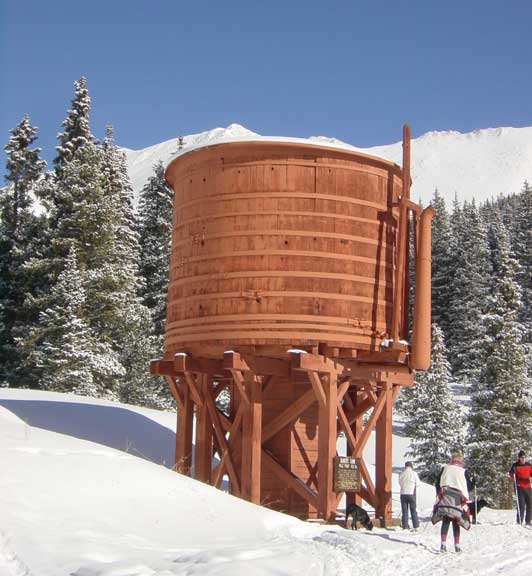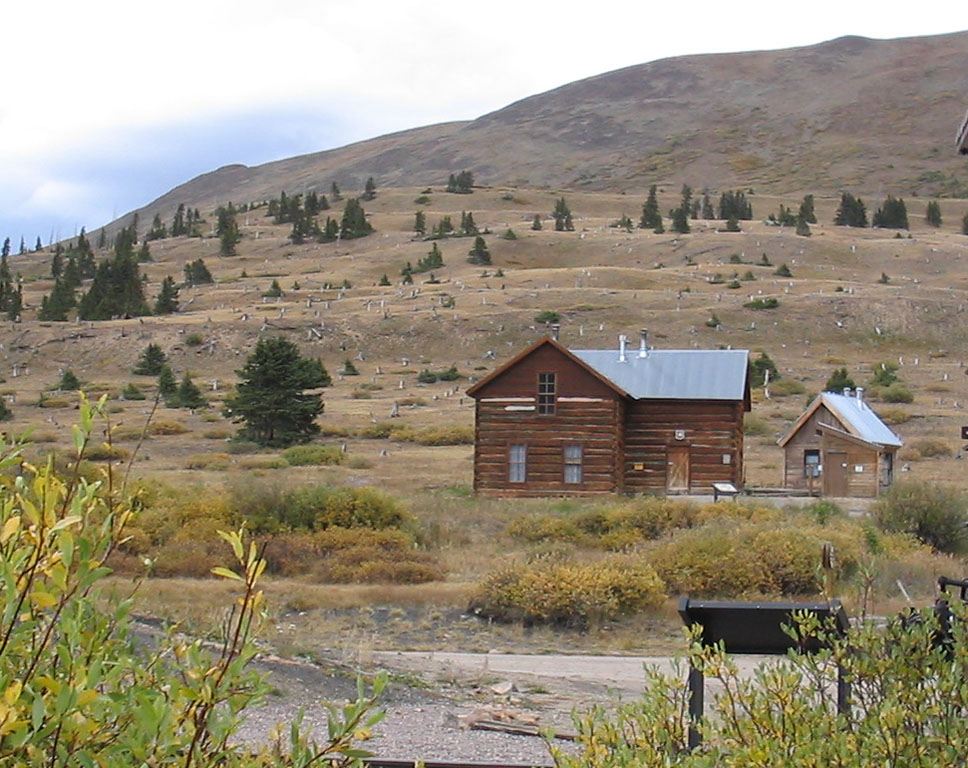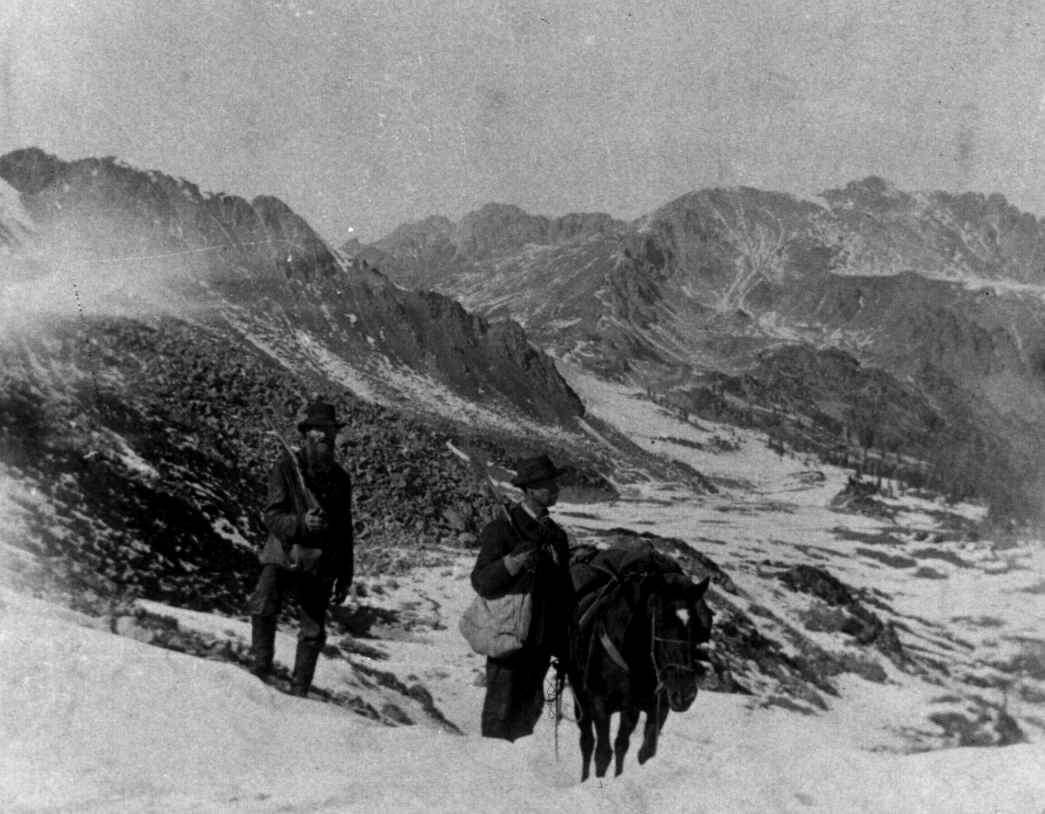|
Boreas Pass
Boreas Pass (elevation ) is a high mountain pass in central Colorado, in the Rocky Mountains of the western United States. The pass is located on the continental divide, at the crest of the Front Range along the border between Park (south) and Summit counties. Description The pass crosses the range where it divides the headwaters of the Blue River (a tributary of the Colorado River) to the north with South Park and the headwaters of the South Platte River to the south. It is traversed by Forest Service Road 33, a gravel road that is closed in winter but passable by two-wheel drive automobiles in good weather. In winter, the road is used by cross-country skiers. The road over the pass goes north from the town of Como in the northern South Park northeast of Fairplay, crossing the path northward to Breckenridge. In good weather, it furnishes an alternative route to nearby Hoosier Pass, offering splendid views of aspen trees and nearby Mount Silverheels and the Tenmile Range. The ... [...More Info...] [...Related Items...] OR: [Wikipedia] [Google] [Baidu] |
Park County, Colorado
Park County is a county located in the U.S. state of Colorado. As of the 2020 census, the population was 17,390. The county seat is Fairplay. The county was named after the large geographic region known as South Park, which was named by early fur traders and trappers in the area. Park County is included in the Denver-Aurora- Lakewood, CO Metropolitan Statistical Area. A majority of the county lies within the boundaries of the South Park National Heritage Area. The geographic center of the State of Colorado is located in Park County. Park County has been and is the location of several important mines, including the defunct Orphan Boy, which was discovered near Alma in 1861 and produced gold, silver, lead, and zinc. The historic Sweet Home Mine, also near Alma, is a former silver mine now known for its rhodochrosite mineral specimens. Geography According to the U.S. Census Bureau, the county has a total area of , of which is land and (0.8%) is water. The headwaters of the S ... [...More Info...] [...Related Items...] OR: [Wikipedia] [Google] [Baidu] |
Aspen
Aspen is a common name for certain tree species; some, but not all, are classified by botanists in the section ''Populus'', of the ''Populus'' genus. Species These species are called aspens: *'' Populus adenopoda'' – Chinese aspen (China, south of ''P. tremula'') *''Populus davidiana'' – Korean aspen (Eastern Asia) *''Populus grandidentata'' – Bigtooth aspen (eastern North America, south of ''P. tremuloides'') *''Populus sieboldii'' – Japanese aspen (Japan) *''Populus tremula'' – Eurasian aspen (northern Europe and Asia) *''Populus tremuloides'' – Quaking aspen or trembling aspen (northern and western North America) Habitat and longevity The trembling of the leaves of the trembling aspen Aspen trees are all native to cold regions with cool summers, in the north of the northern hemisphere, extending south at high-altitude areas such as mountains or high plains. They are all medium-sized deciduous trees reaching tall. In North America, the aspen is referred to ... [...More Info...] [...Related Items...] OR: [Wikipedia] [Google] [Baidu] |
Leadville, Colorado
The City of Leadville is a List of municipalities in Colorado#Statutory city, statutory city that is the county seat, the most populous community, and the only List of municipalities in Colorado, incorporated municipality in Lake County, Colorado, Lake County, Colorado, United States. The city population was 2,602 at the 2010 United States Census, 2010 census and an estimated 2,762 in 2018. It is situated at an elevation of . Leadville is the highest United States Cities and Towns above 10,000 feet, incorporated city in the United States and it is surrounded by two of the tallest Fourteener, 14,000 foot peaks in the state. Leadville is a former silver mining town that lies among the headwaters of the Arkansas River within the Rocky Mountains. The Leadville Historic District, designated a National Historic Landmark in 1961, contains many historic structures and sites of Leadville's mining era. In the late 19th century, Leadville was the second most populous city in Colorado, after ... [...More Info...] [...Related Items...] OR: [Wikipedia] [Google] [Baidu] |
Ancient Greece
Ancient Greece ( el, Ἑλλάς, Hellás) was a northeastern Mediterranean civilization, existing from the Greek Dark Ages of the 12th–9th centuries BC to the end of classical antiquity ( AD 600), that comprised a loose collection of culturally and linguistically related city-states and other territories. Most of these regions were officially unified only once, for 13 years, under Alexander the Great's empire from 336 to 323 BC (though this excludes a number of Greek city-states free from Alexander's jurisdiction in the western Mediterranean, around the Black Sea, Cyprus, and Cyrenaica). In Western history, the era of classical antiquity was immediately followed by the Early Middle Ages and the Byzantine period. Roughly three centuries after the Late Bronze Age collapse of Mycenaean Greece, Greek urban poleis began to form in the 8th century BC, ushering in the Archaic period and the colonization of the Mediterranean Basin. This was followed by the age of Classical G ... [...More Info...] [...Related Items...] OR: [Wikipedia] [Google] [Baidu] |
Anemoi
In ancient Greek religion and myth, the Anemoi (Greek: , 'Winds') were wind gods who were each ascribed a cardinal direction from which their respective winds came (see Classical compass winds), and were each associated with various seasons and weather conditions. They were the progeny of the goddess of the dawn Eos and her husband Astraeus. Etymology The earliest attestation of the word in Greek and of the worship of the winds by the Greeks, are perhaps the Mycenaean Greek word-forms , , , , i.e. 'priestess of the winds'. These words, written in Linear B, are found on the KN Fp 1 and KN Fp 13 tablets. Mythology The Anemoi are minor gods and are subject to the god Aeolus. They were sometimes represented as gusts of wind, and at other times were personified as winged men. They were also sometimes depicted as horses kept in the stables of the storm god Aeolus, who provided Odysseus with the Anemoi in the ''Odyssey''. The Spartans were reported to sacrifice a horse to ... [...More Info...] [...Related Items...] OR: [Wikipedia] [Google] [Baidu] |
Narrow Gauge Railway
A narrow-gauge railway (narrow-gauge railroad in the US) is a railway with a track gauge narrower than standard . Most narrow-gauge railways are between and . Since narrow-gauge railways are usually built with tighter curves, smaller structure gauges, and lighter rails, they can be less costly to build, equip, and operate than standard- or broad-gauge railways (particularly in mountainous or difficult terrain). Lower-cost narrow-gauge railways are often used in mountainous terrain, where engineering savings can be substantial. Lower-cost narrow-gauge railways are often built to serve industries as well as sparsely populated communities where the traffic potential would not justify the cost of a standard- or broad-gauge line. Narrow-gauge railways have specialised use in mines and other environments where a small structure gauge necessitates a small loading gauge. In some countries, narrow gauge is the standard; Japan, Indonesia, Taiwan, New Zealand, South Africa, and the Aust ... [...More Info...] [...Related Items...] OR: [Wikipedia] [Google] [Baidu] |
Denver, South Park And Pacific Railroad
The Denver, South Park, and Pacific Railroad (later called the Denver, Leadville and Gunnison Railway) was a historic narrow gauge railroad that operated in Colorado in the western United States in the late 19th century. The railroad opened up the first rail routes to a large section of the central Colorado mining district in the decades of the mineral boom. The railroad took its name from the fact that its main line from Denver ascended the Platte Canyon and traversed South Park, hence its popular name "The South Park Line." Founded in 1872 by Colorado Governor John Evans, the company was purchased by the Union Pacific Railway in 1880, though it continued to be operated independently. The line went bankrupt in 1889 and was reorganized under a new corporate name as the Denver, Leadville and Gunnison Railway. When the Union Pacific went bankrupt in 1893, the DL&G lines went into receivership and were eventually sold to the Colorado and Southern Railway. In the first half of the 20th ... [...More Info...] [...Related Items...] OR: [Wikipedia] [Google] [Baidu] |
Union Pacific Railroad
The Union Pacific Railroad , legally Union Pacific Railroad Company and often called simply Union Pacific, is a freight-hauling railroad that operates 8,300 locomotives over routes in 23 U.S. states west of Chicago and New Orleans. Union Pacific is the second largest railroad in the United States after BNSF, with which it shares a duopoly on transcontinental freight rail lines in the Western, Midwestern and Southern United States. Founded in 1862, the original Union Pacific Rail Road was part of the first transcontinental railroad project, later known as the Overland Route. Over the next century, UP absorbed the Missouri Pacific Railroad, the Chicago and North Western Transportation Company, the Western Pacific Railroad, the Missouri–Kansas–Texas Railroad and the Chicago, Rock Island and Pacific Railroad. In 1996, the Union Pacific merged with Southern Pacific Transportation Company, itself a giant system that was absorbed by the Denver and Rio Grande Western Railroad ... [...More Info...] [...Related Items...] OR: [Wikipedia] [Google] [Baidu] |
Sidney Dillon
Sidney Dillon (May 7, 1812 – June 9, 1892) was an American railroad executive and one of the US's premier railroad builders. Early life Dillon was born in Northampton, Fulton County, New York. His father, Timothy, was a farmer. Career Sidney Dillon began his career in the industry working as a water boy on the Mohawk and Hudson Railroad, one of America's earliest railroads, for its construction from Albany to Schenectady, New York. In 1840, he went into business for himself, forming his own construction company, and obtaining the construction contract for the Boston and Albany Railroad. He was actively involved in the construction of numerous roads, his largest being the Union Pacific Railroad, with which he became actively involved in 1865 through an equity exchange with the Crédit Mobilier of America corporation. Crédit Mobilier of America was a company set up by the Union Pacific to defraud United States taxpayers in the construction of the First transcontinental rai ... [...More Info...] [...Related Items...] OR: [Wikipedia] [Google] [Baidu] |
Stagecoach
A stagecoach is a four-wheeled public transport coach used to carry paying passengers and light packages on journeys long enough to need a change of horses. It is strongly sprung and generally drawn by four horses although some versions are drawn by six horses. Commonly used before steam-powered rail transport was available, a stagecoach made long scheduled trips using ''stage stations'' or posts where the stagecoach's horses would be replaced by fresh horses. The business of running stagecoaches or the act of journeying in them was known as staging. Some familiar images of the stagecoach are that of a Royal Mail coach passing through a turnpike gate, a Dickensian passenger coach covered in snow pulling up at a coaching inn, a highwayman demanding a coach to "stand and deliver" and a Wells Fargo stagecoach arriving at or leaving a Wild West town. The yard of ale drinking glass is associated by legend with stagecoach drivers, though it was mainly used for drinking feats and ... [...More Info...] [...Related Items...] OR: [Wikipedia] [Google] [Baidu] |
Gold
Gold is a chemical element with the symbol Au (from la, aurum) and atomic number 79. This makes it one of the higher atomic number elements that occur naturally. It is a bright, slightly orange-yellow, dense, soft, malleable, and ductile metal in a pure form. Chemically, gold is a transition metal and a group 11 element. It is one of the least reactive chemical elements and is solid under standard conditions. Gold often occurs in free elemental ( native state), as nuggets or grains, in rocks, veins, and alluvial deposits. It occurs in a solid solution series with the native element silver (as electrum), naturally alloyed with other metals like copper and palladium, and mineral inclusions such as within pyrite. Less commonly, it occurs in minerals as gold compounds, often with tellurium (gold tellurides). Gold is resistant to most acids, though it does dissolve in aqua regia (a mixture of nitric acid and hydrochloric acid), forming a soluble tetrachloroaurate anion. Gold is ... [...More Info...] [...Related Items...] OR: [Wikipedia] [Google] [Baidu] |
Colorado Gold Rush
The Pike's Peak Gold Rush (later known as the Colorado Gold Rush) was the boom in gold prospecting and mining in the Pike's Peak Country of western Kansas Territory and southwestern Nebraska Territory of the United States that began in July 1858 and lasted until roughly the creation of the Colorado Territory on February 28, 1861. An estimated 100,000 gold seekers took part in one of the greatest gold rushes in North American history. The participants in the gold rush were known as " Fifty-Niners" after 1859, the peak year of the rush and often used the motto Pike's Peak or Bust! In fact, the location of the Pike's Peak Gold Rush was centered north of Pike's Peak. The name Pike's Peak Gold Rush was used mainly because of how well known and important Pike's Peak was at the time. Overview The Pike's Peak Gold Rush, which followed the California Gold Rush by approximately one decade, produced a dramatic but temporary influx of migrants and immigrants into the Pike's Peak Country o ... [...More Info...] [...Related Items...] OR: [Wikipedia] [Google] [Baidu] |



.jpg)



.jpg)

